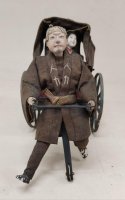Traditional Japanese Ningyō Doll
› Detail › Traditional Japanese Ningyō DollExhibit of the Month 6 / 2024
The traditional Japanese ningyō doll represents a wealthy woman in a rickshaw pulled by a man. This type of doll belongs to a category known as odžima ningyō. They are realistic dolls of Japanese women, named after the famous puppet maker Jirozaburo Kodjima. This doll from the OMGM sub-collections dates back to the turn of the 19th and 20th centuries. Japanese ningyō dolls from this era were among the most popular tourist souvenirs, alongside Japanese weapons and lacquered goods. However, nowadays, due to their cost (even new ones cost between 1500 to 2500 USD each), they hardly leave Japan.
Japanese costume dolls known as išimatcu ningyō are not children's toys (although they originally stem from toys), but they play an important role in traditional Japanese Shinto religion. They are a common decoration of household altars, where they represent the souls of deceased ancestors. They also play a significant role as an important part of certain Shinto festivals and celebrations. Among the most famous are the Shinto festival Hinamatsuri (Doll Festival or Girls' Day) celebrated every March 3rd, and the Kodomo no Hi (Children's Day) festival, which takes place every May 5th.
Traditional Japanese dolls also have their own museum. It is called the Nagashibina Doll Museum and is located in the town of Mochigase, Tottori Prefecture on the main Japanese island of Honshu. In addition to the ritual Shinto nagashibina dolls, you can see up to 1000 other types of all Japanese ningyō dolls here.
Text: Jiří Šlajsna, foto: Dagmar Čechová, Lucie Marková
 en
en cs
cs de
de
